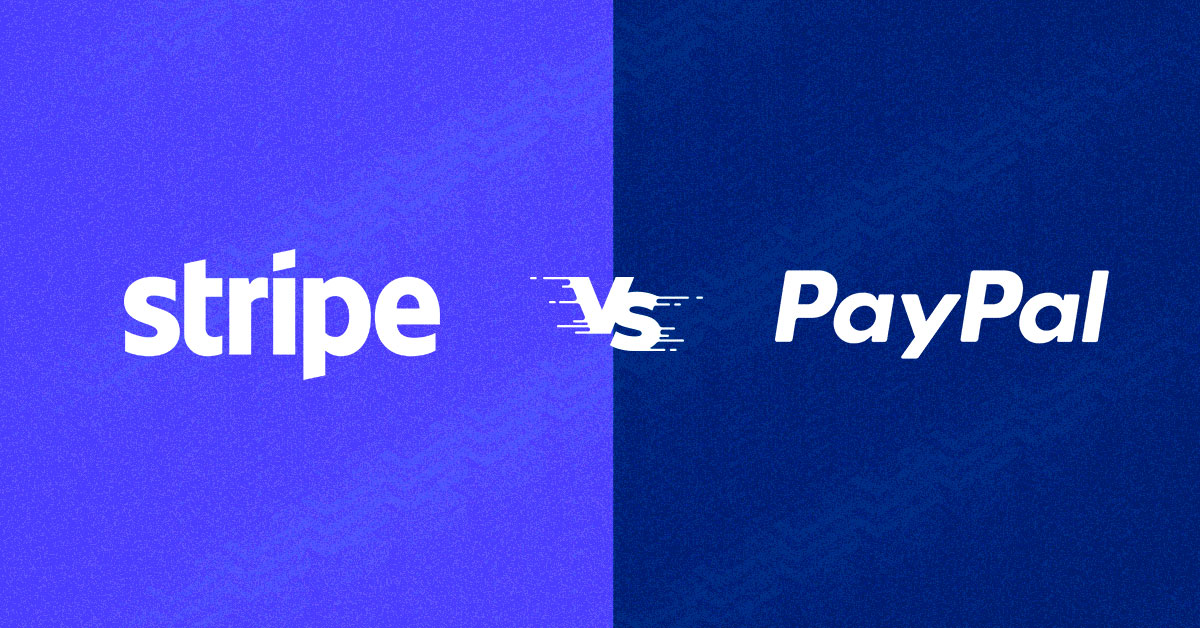
A reliable, sturdy payment gateway is a must for an online store to provide users with a smooth experience for extra conversions and user satisfaction.
Stripe and PayPal are two names that stand out among the top payment gateway providers, but which one is best suited for your online store?
Both have a reputation for being highly secure, but you must choose the one that suits your business needs as well. I have compared both along various metrics to help you pick the right option to expedite your store’s sales.
- A Brief Overview of Stripe and PayPal
- Stripe vs Paypal: A Quick Comparison
- How Do Stripe and PayPal Work?
- How to Choose the Right Payment Gateway
- Stripe vs Paypal: Features Comparison
- Stripe vs PayPal: Which Payment Gateway Is More Popular?
- Stripe vs PayPal: Pros and Cons
- Stripe vs PayPal: The Better Payment Gateway?
A Brief Overview of Stripe and PayPal
Before we jump right into the comparison, let’s learn the basics of these payment gateways. Already acquainted with them? Move over to the comparison table to see how they compete against one another.
What is Stripe?
Stripe is an all-in-one payment processor that helps ecommerce store owners enable payment functionality on the website. Companies worldwide use Stripe and its APIs to manage their businesses, accept payments, and send invoices and payouts.
Since it is a payment gateway service, you cannot purchase the service independently. But you can use it for POS and ecommerce transactions.
Also, Stripe is the ideal payment gateway option for developers, thanks to a plethora of developer tools for ultimate customization.

– Source: Stripe
What is PayPal?
PayPal is also a payment gateway that allows users to send and receive payments online. According to Statista, it currently has 421 million active users worldwide. It’s counted among the biggest brands in ecommerce. PayPal Commerce is primarily focused on ecommerce, but POS payments can be made through PayPal Zettle.
Like Stripe, PayPal is also a user-friendly and developer-centric payment gateway and has a robust set of developer tools.

– Source: PayPal
Stripe vs Paypal: A Quick Comparison
Now that you’ve learned the basics of both Stripe and PayPal, let’s compare them to see which one is a better option for your business.
| Service | Stripe | PayPal |
|---|---|---|
| Transaction fee | 2.9% + $0.30 per transaction | 2.9% + $0.30 per transaction |
| Average payout time | Two business days, or get instant payouts by paying 1% of instant payouts volume. (Minimum fee of 50¢) | 1 to 3 days. Or pay 1.75% of the withdrawal amount for instant transfers for a fee of $0.25 – $25 |
| Inactivity fee | None | None |
| Supported payment methods | Cards, wallets, Apple Pay, Google Pay, Microsoft Pay, ACH Debit/Credit, Cartes Bancaires, JCB, Click to Pay, and more | Pay Later, Venmo, American Express, BLIK, Mastercard, iDEAL, MyBank, eps, and more |
| Contract required | None | None |
| POS system | Yes | Yes |
| Setup cost | None | None |
| Monthly fee | None | None |
| Billing and invoicing | Yes | Yes |
| Ecommerce payment processing | Yes | Yes |
| Customer support | Email, 24/7 Phone & Live Chat, Documentation, and Help Center | Email, Help Center, Phone & Chat, and Documentation |
| Supported countries | 47 | 200+ |
Stripe vs Square: Which Online Payment Gateway to Use in 2023?
How Do Stripe and PayPal Work?
An easy way to view payment gateways is through an envoy who rows information between merchants and banks. Let’s see the workflow of a payment gateway like Stripe and PayPal via a visual breakdown.

How to Choose the Right Payment Gateway
Before you choose a payment gateway, there are several basic questions you should ask.
- Will the payment gateway allow your customers to pay via their phone?
- How difficult would it be to integrate it with your website?
- How many payment methods are available?
- What are the fees & charges?
- Is the payment gateway reliable or not?
I have shortlisted the following 12 key points to compare Stripe and PayPal for a decisive conclusion.
- Ease of Use
- Transaction Costs
- CRM
- Third-Party Integration
- Global Availability
- Supported Currencies
- Supported Payment Methods
- Security and Monitoring
- Developer Tools
- Refunds, Disputes, and Chargeback Fees
- Checkout Experience
- Customer Support
Launch Your Ecommerce Store Effortlessly Today!
Our managed ecommerce hosting solution offers advanced cache that enhance store operations and performance.
Stripe vs Paypal: Features
Let’s compare Stripe and PayPal along the key features to decide which one is an optimum option for your business.
Ease of Use
Stripe and PayPal both focus on ease of use, which is why they are among the leading payment gateways.
However, PayPal beats down Stripe in this category as it primarily focuses on an average user. While anyone can use Stripe, it is a developer-centric platform and can only be used at its full potential by users working with coding lines.
PayPal provides the basic functionality to its users, which can be improved by copy/pasting a few coding lines. Stripe can be integrated with third-party ecommerce tools facilitating the ease of setup, but it is a little more complicated than PayPal.
Transaction Costs
Stripe and PayPal both allow you to get started without any monthly charges. This helps small businesses avoid extra costs if they don’t make any sales.
Other than that, both offer an almost similar fee structure. The base fee for Stripe and PayPal is the same: 2.9% + $0.30. If you make a $100 sale, you’ll have to pay $3.20. The similarity comes down to the fierce competition between the two, but as long as the rivalry keeps the fee down and quality up, we are more than okay with it!

– Source: PayPal
PayPal Fee Calculator – Calculate Your Transaction Fees

– Source: Stripe
Stripe Fee Calculator – Calculate Your Transaction Fees
For international sales, transaction charges increase to 5% for PayPal and 3.9% + 30¢ for Stripe. Of course, if you’re selling globally, Stripe’s fee will look more attractive.

– Source: PayPal

– Source: Stripe
Micropayments
PayPal charges 4.99% + $0.09 for micropayments.

– Source: PayPal
On the other hand, Stripe charges 5% + $0.05 per successful transaction on micropayments.
CRM
Customer Relationship Management (CRM) is a process that deals with business owners interacting with their customers to analyze and study big data.
Stripe offers around 39 CRM partners to help you manage and run your online business without any coding complexities.

– Source: Stripe
PayPal, like Stripe, also offers integrations with CRM tools, including Mailchimp, Zoho CRM, Apptivo, Thryv, and more.

– Source: GetApp
Third-Party Integration
Third-party tools maximize your user experience with their added functionalities and ease the processes through automation.
If you want a simplistic payment processor with a few integrations, then PayPal is your friend. Also, it integrates with the leading ecommerce platforms, including WooCommerce, BigCommerce, Shopify, Wix, and Squarespace.

– Source: PayPal
But if you want a payment processing solution that offers copious third-party integration, then Stripe is the perfect option; it provides ample third-party integrations categorized for 15 industries.

– Source: Stripe
Global Availability
Stripe is available for businesses in 47 countries and plans to expand its reach to more countries with time.

– Source: Stripe
Contrastingly, PayPal provides its services in more than 200 countries, making it easier for you to send and receive payment from anywhere in the world.

– Source: PayPal
Supported Currencies
Stripe supports payments in more than 135 currencies, giving your customers the freedom to pay in their native currency.
PayPal supports only 25 currencies.
Supported Payment Methods
PayPal supports many credit cards, including Visa, American Express, JCB, and MasterCard, but lacks support for many others.
On the contrary, Stripe accepts almost every known debit and credit card along with the following e-wallets: Google Pay, Apple Pay, Alipay, Amex Express Checkout, Microsoft Pay, Visa Checkout, and WeChat.

– Source: Stripe
Security and Monitoring
You need a payment processor that meets the security standards required for ecommerce stores. Fortunately, Stripe and PayPal are both PCI-compliant, assuring they meet the Payment Card Industry’s strict standards and ensuring your data is securely stored.
Stripe provides all the essential security features, including the encryption of payment data, secure data migration, fraud detection, 3D secure authentication, payment risk evaluation, and online identity verification.
PayPal also solidifies its security with features like a security key, data protection, fraud detection, key pinning, TLS connection, and email confirmations.
Stripe charges refundable dispute fees of $15, which is a bit lower than PayPal ($20). However, PayPal only charges the dispute fees for those transactions that aren’t processed through the buyer’s PayPal account.
Developer Tools
Both Stripe and PayPal can be customized using coding lines. But if we talk about the developer tools, then Stripe has the upper hand on PayPal.
PayPal requires some improvement in its developer support, as its documentation isn’t that comprehensive. It offers a demo portal, API executor, and Sandbox testing guide as the developer resources.

– Source: PayPal
Stripe offers the following list of developer tools:
- Stripe Shell
- Stripe CLI
- Developers Dashboard
- Stripe for Visual Studio Code
- Incoming webhooks
- File Upload API
- Stripe Connectors
Read the Stripe developer documentation for more information.
Refunds, Disputes, and Chargeback Fees
When a user files for a chargeback, payments tend to get stuck in the pipeline, and you’ll most likely incur some extra costs. A Stripe vs. PayPal fees overview will give you a clear idea of the better option.
PayPal allows customers to file for chargeback in the following cases:
- When they haven’t received their item.
- In the case of a damaged or defective item.
- Don’t recognize a credit card charge.
- When they’re charged more than once for something.
- When they didn’t authorize a payment.
If a chargeback is approved, the customer is reimbursed with the amount, but PayPal levies you, the seller, $20 as chargeback fees.

– Source: PayPal
On the other hand, Stripe charges $15 as a chargeback fee in case of disputes. However, Stripe offers merchants the ability to avoid charge card scams with their remarkable and brand-new Stripe Radar functions.

– Source: Stripe
If you’re sure there will be some chargebacks on your online store but don’t want to pay much, Stripe should be your go-to payment gateway.
Checkout Experience
Checkout experience greatly impacts the user experience and determines your website’s ease of use. You don’t want to trouble your customers with a bad checkout experience once they’ve filled their cart on your online store.
Both Stripe and PayPal offer a pre-built checkout experience that takes the payment information and processes it.
Stripe’s checkout experience is somehow simpler than that of PayPal. With Stripe, your customers just have to enter their card digits, and once they hit the submit button, they’re redirected to the follow-up page.
But with PayPal, when you click on the PayPal Checkout button, you have to log in and bear the loading time. After that, you have to make a few more selections, making the process lengthier than that of Stripe.
Customer Support
Customer support is yet another strong deciding factor for a payment gateway selection. You are likely to run into problems and blockages with every platform, and you require prompt support.
PayPal offers support via phone calls, live chat (bot), help center, and documentation.

– Source: PayPal
Stripe provides more support options than PayPal. You can reach out to them via phone call, email, or talk to their agent on an online chat. You can also ask general questions on their support forum and use their IRC channel for instant technical assistance.

– Source: Stripe
Stripe vs PayPal: Which Payment Gateway Is More Popular?
Both Stripe and PayPal enjoy favorable user reviews and ample popularity. But to actually see how they compare against each other in terms of popularity, let’s look at their Google trends numbers.
Stripe vs PayPal: Pros and Cons
Stripe
Pros
- Customized checkout experience
- 24/7 support
- Accepts international payments
- Supports ACH payments
- Affordable
- Full integration
Cons
- Only available in 47 countries
- Difficult to set up for beginners
- Developer-focused
- Paid credit card readers
PayPal
Pros
- Ideal for small to mid-sized ecommerce stores
- Available in 200+ countries
- Beginner-friendly
- Free online invoicing
- Easy integration
- Multiple ecommerce features
Cons
- Less customization
- $20 chargeback fee
- Lacks POS feature
- Limited payment methods
Stripe vs PayPal: The Better Payment Gateway?
I have compared both PayPal and Stripe along various metrics to find the better option. Both of these payment gateways offer their own unique features, services, and restrictions. The final call lies upon you to decide which payment gateway suits you the best.
While PayPal is available in almost all countries, only Stripe is limited to 47 countries. However, Stripe is a more affordable option than PayPal, so the final decision depends upon your requirements.
Which payment gateway are you using for your business or organization? Let us know in the comment section below.
Frequently Asked Questions
Q. Is it better to use Stripe or PayPal?
Both Stripe and PayPal are trusted and reliable payment gateways and the selection of the two depends upon your business and requirements. If you are looking for a budget-friendly option, then Stripe is better than PayPal. If you want a more recognized and widely available payment gateway, PayPal is a better option. Also, Stripe is best suited for large businesses, while PayPal is ideal for small to mid businesses.
Q. Is Stripe safer than PayPal?
Stripe and PayPal are both PCI-compliant as highly secure payment gateways. Stripe provides payment data encryption, fraud, risk detection, and online identity verification, among other security features. PayPal offers data protection, TLS connection, email confirmations, etc., as its security features.
Q. Does PayPal work with Stripe?
No, you cannot integrate Stripe with PayPal. However, you can use both payment gateways on your online store to accept payments separately.
Q. Can I use both Stripe and PayPal?
Yes, you can use both Stripe and PayPal on your website. You will have to set up accounts with each, allowing your customers to choose their preferred payment method.
Q. Can Stripe accept international payments?
Yes, Stripe can support international payments, and it supports presentment in more than 135 currencies.
Q. Does Stripe accept debit cards?
Yes, Stripe accepts all major debit and credit cards from customers in all its available countries.
Sarim Javaid
Sarim Javaid is a Sr. Content Marketing Manager at Cloudways, where his role involves shaping compelling narratives and strategic content. Skilled at crafting cohesive stories from a flurry of ideas, Sarim's writing is driven by curiosity and a deep fascination with Google's evolving algorithms. Beyond the professional sphere, he's a music and art admirer and an overly-excited person.

